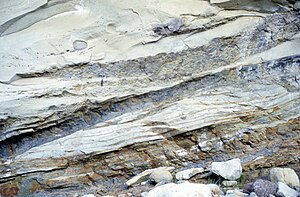Rip-up clasts
Appearance


Rip-up clasts are pieces of shale or mudstone created when an erosive current containing suspended sediment flows over a shale bed, tears up pieces of it, and carries these "rip ups" some distance. Because clay can be quite cohesive, even when freshly deposited, large clasts of shale can be ripped up, transported and subsequently preserved when the eroding current finally deposits its sediment. Shale rip-up clasts are often found at the base of sandy turbidites, in lag deposits at the base of channelized sandstones, and associated with subaqueous dunes and bars.[1][2]
